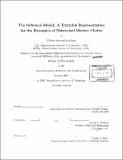The influence model : a tractable representation for the dynamics of networked Markov chains
Author(s)
Asavathiratham, Chalee
DownloadFull printable version (14.26Mb)
Other Contributors
Massachusetts Institute of Technology. Dept. of Electrical Engineering and Computer Science.
Advisor
George Verghese.
Terms of use
Metadata
Show full item recordAbstract
In this thesis we introduce and analyze the influence model, a particular but tractable mathematical representation of random, dynamical interactions on networks. Specifically, an influence model consists of a network of nodes, each with a status that evolves over time. The evolution of the status at a node is according to an internal Markov chain, but with transition probabilities that depend not only on the current status of that node, but also on the statuses of the neighboring nodes. Thus, interactions among the nodes occur probabilistically, starting when a change of status at one node alters the transition probabilities of its neighbors, which then alter those of their neighbors, and so on. More technically, the influence model is a discrete-time Markov process whose state space is the tensor product of the statuses of all the local Markov chains. We show that certain aspects of the dynamics of the influence model can be studied through the influence matrix, a reduced-order matrix whose dimension is the sum rather than the product of the local chain dimensions. We explore the eigenstructure of the influence matrix and explicitly describe how it is related to that of the full-order transition matrix. From the influence matrix, we also obtain the influence graph, which allows the recurrent states of the influence model to be found by graph-theoretic analysis on the reduced-order graph. A nested hierarchy of higher-order influence matrices, obtained from Kronecker powers of the first-order influence matrix, is exposed. Calculations on these matrices allow us to obtain progressively more elaborate statistics of the model at the expense of progressively greater computational burden. As a particular application of the influence model, we analyze the "to link or not to link" dilemma. Suppose that a node is either in a 'healthy' or 'failed' status. Given that connecting to the network makes its status dependent on those of its neighbors, is it worthwhile for a node to connect to the network at all? If so, which nodes should it connect to in order to maximize the 'healthy' time? We formulate these questions in the framework of the influence model, and obtain answers within this framework. Finally, we outline potential areas for future research.
Description
Thesis (Ph.D.)--Massachusetts Institute of Technology, Dept. of Electrical Engineering and Computer Science, 2001. Includes bibliographical references (p. 186-188).
Date issued
2001Department
Massachusetts Institute of Technology. Department of Electrical Engineering and Computer SciencePublisher
Massachusetts Institute of Technology
Keywords
Electrical Engineering and Computer Science.